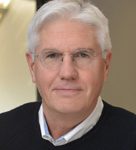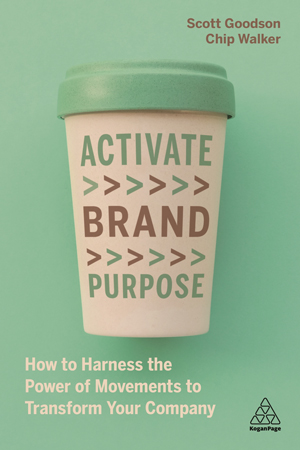 By Stephen Shaw
By Stephen Shaw
Practically every corporate boss these days has it on their to-do list — coming up with a business purpose beyond making money. Most of the time they feel it’s a bit too touchy-feely an assignment when the only thing they really care about — what they get handsomely rewarded for — what the board and shareholders and financial analysts expect of them — what they were trained to do in B-school — is generate faster growth and higher earnings. But they also feel the growing public pressure to position their business as a socially responsible corporate citizen. To be seen as heroes and not villains. And so they go through the motions of defining their business purpose.
The CEO might choose to hold a facilitated retreat amongst the executive team and define that purpose behind closed doors. Or the job might be handed to marketing, thinking it’s nothing more than a public relations initiative. Or they might mistake it for a Corporate Social Responsibility campaign. The outcome, in every case, is exactly the same: a lame purpose statement followed by an ostentatious launch event and internal rallies to inspire the troops, accompanied by some external fanfare, just so the public is aware. But then that initial surge of enthusiasm fades away. All that is left, a year or so later, is a wall poster, a revised “About Us” page on the web site, and communication slogans from a now dormant ad campaign. Back to business as usual.
No wonder the critics of brand purpose are so shrill in their opposition to it. The acerbic Marketing Week columnist Mark Ritson calls it “moronic”. Another equally churlish marketing expert Byron Sharp accused proponents of learning their economic history in art school. And of course activist investors loathe the idea. Even Unilever, whose commitment to sustainability is undisputed, came under attack, mocked by one large equity investor as “losing the plot”.
Yet, despite the nasty criticism, there is a business purpose to having a brand purpose. Because the public perception today is that corporations are the enemy, responsible in one way or another for many of the ills in society, from growing income disparity to workplace discrimination to environmental pollution. So corporate reputations are at stake. Companies which act as pariahs just put social stability at risk which is never good for business.
The long-held Friedman doctrine that business has only one purpose, to make shareholders rich, is now pretty much discredited. Instead business leaders are being advised, rightly, to put customers first — to do no harm — to be law-abiding members of society — to commit resources toward societal change. And the most influential proponents of this reformist movement — called “stakeholder capitalism” — are the corporate elite themselves (in the form of the Business Roundtable) and kingpin capitalists like BlackRock’s Larry Fink who wags his finger at his corporate peers, saying, “Your company’s purpose is its north star in this tumultuous environment”.
 But here is where the confusion sets in. Is a brand purpose simply a lofty statement of principle? Or should it be a more prosaic “Why We Do What We Do” reason for why the brand exists? Should it be connected to what the business actually does — or serve as a more visionary “Big Hairy Audacious Idea” that will change the world? Or maybe it should simply be a poetic aspirational statement (Apple’s credo, for example, starts with “We are here to enrich lives”). No wonder so many brand purpose statements end up as bland platitudes: no one can agree on what it really represents. Or they prefer to play it safe so no one will be offended (most of all the shareholders), watering it down to a bumper sticker slogan. Which is why purpose statements tend to be quickly forgotten.
But here is where the confusion sets in. Is a brand purpose simply a lofty statement of principle? Or should it be a more prosaic “Why We Do What We Do” reason for why the brand exists? Should it be connected to what the business actually does — or serve as a more visionary “Big Hairy Audacious Idea” that will change the world? Or maybe it should simply be a poetic aspirational statement (Apple’s credo, for example, starts with “We are here to enrich lives”). No wonder so many brand purpose statements end up as bland platitudes: no one can agree on what it really represents. Or they prefer to play it safe so no one will be offended (most of all the shareholders), watering it down to a bumper sticker slogan. Which is why purpose statements tend to be quickly forgotten.
That’s a paradox Scott Goodson recognized very early on in his career — what he calls the “purpose gap” — as he helped some of the worlds most iconic Swedish brands grow into global powerhouses. Now based in New York City, his agency continues to work with leading brands to not just define their purpose, but to activate it through active socialization — in other words, to make the purpose statement come to life, both through actions and words. His latest book “Activate Brand Purpose”, which he co-authored with his colleague Chip Walker, is a handbook for business leaders to transform their companies by harnessing the “power of movements”.
Shaw: What’s the origin story behind your quirky agency name?
Goodson: I grew up in Canada but in the 1980s moved to Sweden where I owned an agency for about a decade. At the time all these Swedish corporations were just starting to globalize. I got to work with Ikea, with Ericsson (which made 60 percent of the world’s mobile phones back then), with Stefan Persson1 at H&M. What the Swedes taught me is that you don’t need to have a huge agency infrastructure to deliver great marketing on a global scale. With Ericsson, we would launch their mobile phone in the Nordics and then we would do it in Germany and then in Italy and Spain, Poland, Thailand, Australia, Brazil, the U.S., and so forth, and in Canada. My company was the antithesis of the big corporate agency. And so when I sold my company and started StrawberryFrog in Amsterdam in the late ‘90s, I wanted a name that was a little more original than David versus Goliath. There was an article at the time describing corporate agencies as dinosaurs. So we looked for an amphibian, and the rarest frog in the world is actually a strawberry frog.
Shaw: How would you describe the purpose of your agency?
Goodson: Our purpose when we started was “creativity for good” — creating good results for our clients, for our teammates, for the world. And so, everything that we’ve done since we started, whenever we’re developing a new idea, has been with that in mind: how can we bring that higher level of positive contribution to our clients? Where we can say candidly, “It’s not to your benefit if you’re making your people sick or poorer. They should be financially better off. They should eat good food. Their children should live in comfortable, confident, secure communities”. And more often than not, the leaders of those companies will agree. And they’ll say, “Yes, we should try to do that.”
Shaw: In other words you’re not just another agency writing clever headlines — you’re actually change agents.
Goodson: Yeah. Change agents working with leaders that want to put purpose at the core of their business. Half our business today is something we call “Movement Inside”, where we do purpose-driven transformation. We’re doing this with Walmart, we’re doing it with Pfizer. And then the other half is “Movement Outside”, which is marketing and advertising, using purpose as the driver of brand activation. And the marketing part doesn’t necessarily have to involve advertising or paid media. It can be actions, it can be events, things like that.
Shaw: How did you arrive at “movement thinking” as your defining idea?
Goodson: Sweden is almost like the conscience of the world, or at least they were when I was there. Swedish consumers have always been more demanding of their companies. They wanted less packaging because they thought it was bad for the environment. They wanted more women on boards because they felt women were underrepresented. So we were doing purpose strategies back in the late ‘80s, early ‘90s for these Swedish companies. When we worked with Ikea in the Nordics, everybody understood that the brand was more than just a furniture company. But outside of Sweden, in other parts of Europe, people just didn’t understand the concept of purpose. They couldn’t wrap their heads around it. And I saw the same was true when we marketed Swedish companies in Asia or in Eastern Europe or in the U.S. We’d say “Let’s use the principles of societal movements as a means of organizing people and mobilizing people to be part of something bigger”, and people would say, “What are you talking about?”.
When we started StrawberryFrog our first client was the Swatch Smart Car2. Swatch was responsible for marketing and Mercedes for manufacturing. We launched it as a movement to re-invent the urban environment. And it really did a great job of separating this small two-seater from the rest of the two-seaters that were being sold in Europe. And from there we just started focusing on movements.
Shaw: You believe that the concept of movements will be the way brands are built in future.
Goodson: To build a brand today it’s important that you define what you’re doing in the world rather than just develop some creative idea to get people to look at you. People are looking for more meaning in their lives. We’re living in a time when people realize that their well-being is dependent on the well-being of other human beings. We realize that we are not living in isolation. We’re very much dependent on the community around us. So that’s why the brand becomes less important, especially since no one’s watching television, no one’s looking at print advertising, even digital advertising. How do you actually engage anyone? Well, I think you connect with people about a higher purpose. But how do you activate purpose in such a way that all the different stakeholders, including consumers and customers and investors and employees, will not only believe in what you’re trying to do, but help build it with you? That’s what we mean by movement thinking.
Shaw: Brand purpose can be confusing for people, never mind the idea of movements. For purpose to work, how important is it that there’s a clear connection to what the organization actually does?
Goodson: I think the best way to think about purpose is what are you doing in this world of ours beyond just making money? How can you add value to people’s lives beyond simply economic value? How are you making this world a better place? How are you making it better for your employees? How are you making it better for your customers and shareholders? That’s perhaps the easiest way to think about it — and then you try to come up with an original way to think about it. And perhaps more important, how to activate it.
A few years ago, there was an ad on the Super Bowl for Planters peanuts which said not paying women the same as men is nuts. I think that’s why we have cancel culture, because a lot of people are fed up with companies trying to do business on the back of important cultural and societal shifts. Giving lip service to it only undermines the brand. You have to have something in your purpose, something in your brand, that connects them.
Shaw: Why is “movement thinking” so key to success?
Goodson: The idea that the top of the organization is going to do all the strategic thinking and then hand it over to employees to execute is old-fashioned. That top-down world no longer exists. If you’re leading an organization, you’re not going to be effective if you demand compliance and expect people to execute. And if you demand compliance from younger employees today, they’re more likely to give you the middle finger and go work somewhere else. You’re much surer to succeed if you bring along the organization with you: “Let’s do this because it’s important to all of us.” A movement is a mobilizing force in the service of a higher order idea, which individuals have a role in choosing. They’re not simply executing; they’re part of building the strategy with you because they feel it’s right. You are actually inviting your employees to help build something together.
Shaw: Most CEOs still think that their first and only stakeholder is a shareholder. How do you get them to shift from that mindset to the democratization of the workplace as you describe it?
Goodson: I think it’s very clear that successful companies today think much more about the dynamism of their employees and the communities within which they live. People are looking for businesses to support a healthy community. And it’s in the interest of companies to foster that. It’s also in the interest of companies to not poison people. It’s in the interest of companies to educate people. It’s in the interest of companies to do a lot of things that move people forward.
There’s a great book by Felix Oberholzer-Gee, a professor at Harvard Business School, called “Better, Simpler Strategy.”3 He favors using purpose as the highest order strategy because it really is highly motivating. It goes beyond simply generating revenue and profit. There’s an emotional aspect to it. And you can use that to inspire the organization.
Shaw: But the vast majority of CEOs treat purpose as a checkmark, really, on their list of to-dos.
Goodson: Well, I think there are some organizations that do put purpose at the core of their business. It’s not a marketing strategy; it’s a core business strategy. Companies like Mahindra4 where they genuinely have put purpose at the core of their business. And it’s a huge industrial group. It’s like if you put GE together with GM and Walmart. Unilever is another company which is really trying to put purpose at the core of the business.
We’re living in a time where the problems we face are getting worse and a lot of those problems are caused by corporations and the way they do business. We’re also living in a time when CEO pay is going through the roof, even in mediocre-performing companies. So something has to give. In the book, we introduce the idea of “movement shares”. People can buy equity for not only financial gain, but also the positive impact they’re having in the world. And I think those types of ideas will become more important as the negative impact of capitalism continues.
Shaw: In the book, you call out Byron Sharp and Mark Ritson5. They’ve both been harsh critics of brand purpose. What do you make of their revanchist opinions?
Goodson: They’re thinking of purpose as a marketing platform. But it’s not a marketing platform. It is a business strategy for how business can conduct itself in a way that works for everyone, not just the few. The Business Roundtable6 understands that. Doug McMillon, the CEO of Walmart, understands it. Capitalism may be the most successful economic system to ever exist, but it’s destroying the planet.
Shaw: Purpose can also be a brand differentiator in a commoditized marketplace. You cite Tesla as an example.
Goodson: Yeah, it can be a highly motivating reason to purchase. It increases the willingness of people to buy from a company, and it increases the willingness of people to go work for that company. People who drive Tesla see it as this purpose-driven organization using electricity to innovate new mobility solutions. And I think that’s highly motivating for people to buy Tesla.
Shaw: How would you describe the role of marketing in the process of defining the right purpose, and ultimately activating it?
Goodson: I think marketing is used to using language and communications to express ideas. That’s why people tend to associate purpose with marketing. Because it takes what is in fact a business strategy, and makes it emotional and easy to understand, and motivating. Marketers are good at communicating, good at writing. Activating purpose is the tougher challenge. Everybody has a purpose these days, but it hasn’t been activated either inside the organization amongst employees, or outside the organization amongst different stakeholders, including customers. And that’s really the challenge. How do you take a purpose and then activate it in an original way so that it becomes the thing that increases people’s willingness to buy from, or work for, a company? If you’re a CEO of a company, what should you do? If you’re the CFO, what role do you have? The book is largely about giving really clear recommendations to business leaders on how they can bring purpose to life.
Shaw: Can you explain how your Purpose Power Index was created, and why Seventh Generation7, a cleaning company, ended up being the top ranked company?
Goodson: When we started focusing on activating purpose with movement thinking, which is what we do at StrawberryFrog, we wanted to have some kind of monitoring system that we could use to measure the impact of purpose, both among consumers and employees. But there was no empirical study of purpose anywhere in the world. So we created the first ever measure of purpose. We asked 20,000 U.S. consumers to score brands based on what they’re doing more to make the world a better place. Many of the laggards were technology companies. In the early 2000s, we thought that technology companies were going to usher in a new era of democracy and help bring about a more equitable society. And what we realized is they’re actually self-serving and quite the opposite. They’re…
Shaw: Mercenary.
Goodson: …mercenary. Yeah. And I think a lot of people now realize that what is going on is really quite toxic. Apple did better because of their stand for privacy. But it’s not enough to be a cool company anymore. You have to be doing something.
Shaw: One of the surprises for me was that Nike didn’t make the top 100 – I think they were 165th out of the 400 or so that you named. Why the low ranking for Nike?
Goodson: During the protests that followed the George Floyd murder, Nike came out publicly in support of BLM. But then it turned out that none of their senior executives were African American. And so I think it was an example of where the advertising didn’t reflect the actual way the company conducted itself. It’s not enough just to have cool advertising. You really need to walk the talk. You need to do what you say you’re going to do.
Shaw: Unilever is in your top 100, along with Ben and Jerry’s. I’m sure you’re familiar with the spat that’s going on between them, with Ben and Jerry’s accusing Unilever of undermining their social mission8. Yet this is the same Unilever that wants every brand to have a distinct social purpose. Is this what happens when purpose collides head on with the pursuit of profit?
Goodson: There was a lot of criticism of Unilever a couple of years ago that their performance wasn’t as good as it should be. But if you just looked at the brands that were purpose-driven, they actually had a significantly higher return on investment than the ones that weren’t. On the other hand, you have the example of Danone whose CEO was terminated because he said he wanted to have a purpose-driven corporation9. Well, the problem was he had poor financial results and was using purpose as a way to cover up that. But critics conflated the two and said that because he was focused on purpose, he had bad economic results. Except no, that wasn’t the case. But there are a lot of critics of purpose out there with their own agendas.
Shaw: Well, for every movement there is a countermovement.
Goodson: There can be, of course.
Shaw: Nike did face a countermovement of sorts during the Kaepernick controversy10, although that turned out quite well for them in the end because it had a positive impact on sales. But it must be tough to take that kind of gamble, unless you’re Phil Knight, a co-founder of the company.
Goodson: It’s hard to make a stand for something that’s important. Like a lot of companies did when they pulled out of the all-star baseball game after Georgia passed those border restriction laws. Or when Disney took a stand for LGBTQ rights in Florida. Companies that do will inevitably be criticized. I think ultimately Disney will have demonstrated to a large group of people that they embrace a diverse community which also happens to be a large part of their employee base.
We worked with an extraordinary individual who leads the sixth largest bank called Truist. The company came out of a merger that happened just prior to COVID. We’ve been working with them since the inception of the new organization. The purpose was actually written by the CEO and his C-suite. The purpose is building better lives in communities. Now, it’s a great idea on the simple basis that it focuses on the customer as opposed to the products. And it goes beyond the customer. It focuses on the communities where they live. Five minutes after they wrote that down, COVID happened. They were the first bank in the United States to come out with a comprehensive program to put money into communities despite the fact that everything’s shut down. It took other banks months. So having a purpose allows you to move quickly in a crisis situation. And I think leaders are becoming more aware of that right now.
Shaw: And they don’t want to be seen as pariahs, I suspect.
Goodson: Or they don’t want to get caught flatfooted. That bank is highly regarded now because of their behavior during those first few months of COVID.
Shaw: It’s also got to be hard for leaders to build a broad consensus around defining the brand purpose, especially if you have a large employee workforce where there’s likely to be polarized worldviews.
Goodson: We just finished working on an assignment for a challenger brand in the consulting, public accounting, and technology space. It’s a company called Crowe. We worked with many of their internal teams to develop this big idea for them which is called “embrace volatility”. We live in an age of uncertainty which is a real conundrum for business leaders. They need to see opportunity in crisis, as opposed to fear and worry. Because if you’re fearful, you can’t lead an organization through a difficult period. But if you work with this consulting firm, you can navigate this economy we’re living in without being at the mercy of it. And that is a really big and original idea. And we did it because we were able to get people to participate in developing the strategy with us.
Shaw: So you’re saying that it’s really important to have grassroots engagement from the very beginning?
Goodson: Yes, absolutely. It’s no longer effective to work with a tiny group of people in the marketing department and then launch it. Instead you need to build it together with all the different folks that you’re trying to bring on board. Like I said earlier, you can’t divide the company between the top of the company who are the strategy people and the rest of the company who are just going to execute.
Shaw: The other thing is staying true to your stated values if the brand purpose is to come across as authentic.
Goodson: Absolutely. I mean, look, the world is full of problems to be solved. And each one of those represents immense opportunity for businesses. So why focus on ideas the world doesn’t need when there’s so much opportunity solving problems? To me, that’s the crux of purpose.
- Stefan Persson was the chairman of H&M until 2020 and remains the company’s largest shareholder.
- Originally called the Swatchmobile, the car was a joint venture with Swatch and Mercedes. The Swatch Mercedes Smart Car made its debut in 1997.
- Companies that win, Oberholzer-Gee argues, maximize the customer’s willingness-to-pay and the employee’s willingness-to-sell their services to the business.
- Mahindra is an Indian multinational automotive manufacturing corporation.
- Mark Ritson and Byron Sharp are two U.K. marketing experts known for their iconoclastic views.
- The Business Roundtable is an association of CEOs from 181 of America’s top companies.
- Seventh Generation is U.S.-based company now owned by Unilever that sells eco-friendly household products.
- Unilever sold the Ben & Jerry’s business in Israel to a local licensee when the independently run Ben & Jerry’s wanted to end sales in what they felt was “Occupied Palestinian Territory” because it was “inconsistent with its values”.
- Danone Chairman Emmanuel Faber was popular with environmentalists for his strategy “One Planet, One Health,” but was ousted by activist investors when he wanted to link the company’s success to its environmental record.
- “It doesn’t matter how many people hate your brand as long as enough people love it,” Nike Co-founder Phil Knight said in explaining the company’s controversial Kaepernick ad (“Believe in something. Even if it means sacrificing everything”).
Stephen Shaw is the Chief Strategy Officer of Kenna, a marketing solutions provider specializing in delivering a more unified customer experience. Stephen can be reached via e-mail at sshaw@kenna.ca




